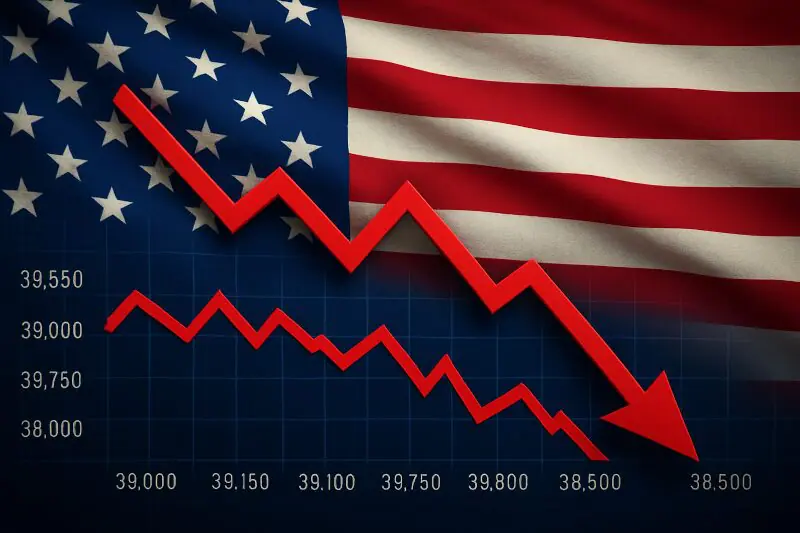We are now 100 days into Donald Trump’s second term and the story playing out in real-time is crystal clear to anyone watching the economy with their eyes open.
Forget the noise. Forget the “messaging” from Trump’s team. Forget the partisan pundits still screaming into the void on cable news. There’s only one thing that’s driving the current collapse in his public approval: the economy. And no amount of tweeting, rallying, or meme posting can spin away the hard financial reality Americans are living through right now.
When Trump took the oath again on January 20, the Dow Jones was hovering just shy of 40,000, consumer sentiment had stabilized after a rocky 2024, and Wall Street’s conventional wisdom was simple: brace for volatility, but don’t panic.
Fast forward to today. The Dow has shed nearly 3,500 points. The S&P 500 is down 8.7%. The Nasdaq has been even uglier, flirting with correction territory after a brutal first quarter that saw tech giants like Apple, Microsoft, and Amazon all post earnings misses for the first time since the pandemic.
Meanwhile, inflation, which Trump had vowed to “crush back to the 2% target,” is stubbornly stuck at 4.8%, according to the latest CPI data. Wages are rising too, but not fast enough to outrun rent hikes, grocery bills, or the explosion in credit card interest rates. As the cost of living keeps creeping higher, American wallets are getting thinner. The University of Michigan’s latest survey shows consumer sentiment has collapsed to levels not seen since the Great Recession.
And it gets worse.
The first official GDP print for 2025 is out and it’s a gut punch: a 1.6% annualized contraction, per the Bureau of Economic Analysis. A full-blown recession might not be “official” yet because the National Bureau of Economic Research likes to wait months before declaring one but for millions of Americans, it already feels like one. Home foreclosures have jumped 21% compared to this time last year. Auto loan delinquencies are spiking. Credit card debt has crossed $1.2 trillion for the first time in U.S. history.
This isn’t just “bad optics.” It’s real. It’s happening.
And the American people know exactly who’s sitting in the big chair right now.
Trump’s approval rating sits at a brutal 39%, per the latest ABC News/Washington Post/Ipsos poll, the lowest 100-day approval for any sitting president since modern polling began. Even his so-called “hidden base,” the blue-collar workers without college degrees that fueled his 2016 upset, are cracking. Forty-one percent of them say their personal finances have worsened since Trump took office again. Fifty-three percent of all voters say the economy is worse now than in January.
You can’t spin that.
And it’s not just Main Street that’s souring. Wall Street is shifting its money, fast. Institutional investors have been yanking cash out of U.S. equities at the highest pace since the COVID crash of 2020, according to Bloomberg tracking data. They’re piling into gold, Treasuries, and emerging markets, the classic flight-to-safety move that signals deepening fear under the hood.
Ironically, some of the pressure Trump put on the economy was self-inflicted.
The new tariffs slapped on Chinese and European imports back in February triggered immediate retaliation. American farmers got hit first, soybeans, pork, and dairy exports plunged. Then manufacturers felt it. Rising input costs hammered industries that Trump once championed, from steel to autos to heavy equipment. Deere & Co. and Caterpillar both issued profit warnings. Ford halted production at two plants citing “supply chain imbalances” and “unsustainable cost pressures.”
The stock market noticed. The American worker noticed. Consumers definitely noticed.
Trump’s team has been trying to sell this as “short-term pain for long-term gain,” but voters have heard that song before. They heard it in 2018 during the first trade war. They heard it again in 2020 when the pandemic economy was in freefall. And they’re hearing it now while watching their 401(k)s shrink and their grocery bills climb.
There’s another brutal undercurrent to this: the credibility gap.
When Trump took office in 2017, despite the controversies, there was a certain “benefit of the doubt” factor baked in. Voters were willing to wait and see. Now, after nearly a decade in public life and two presidential terms, that benefit is gone. The American people are judging the situation with cold, hard eyes: if you’re hurting my wallet, you’re losing my support. Period.
And for those banking on a magical second-half turnaround? Not looking great either.
Analysts at Morgan Stanley and JP Morgan have slashed their full-year GDP forecasts to between 0.5% and 0.8%, citing continued consumer weakness, slowing housing markets, and ongoing trade tensions. Inflation expectations remain elevated for at least another 12 months, per CME FedWatch futures. Even the Federal Reserve, typically cautious about painting a gloomy picture, has conceded that “material downside risks to growth” have reemerged.
If the current trajectory holds, we’re staring down a potential full-year recession.
That’s the world Trump is navigating now.
And unless the next 100 days look radically different than the first, history suggests he’s steering straight toward a political hurricane.




